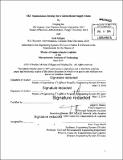| dc.contributor.advisor | Edgar E. Blanco. | en_US |
| dc.contributor.author | Jin, Huiping, M. Eng. Massachusetts Institute of Technology | en_US |
| dc.contributor.author | Gilligan, Brad | en_US |
| dc.contributor.other | Massachusetts Institute of Technology. Engineering Systems Division. | en_US |
| dc.date.accessioned | 2014-12-08T18:49:53Z | |
| dc.date.available | 2014-12-08T18:49:53Z | |
| dc.date.copyright | 2014 | en_US |
| dc.date.issued | 2014 | en_US |
| dc.identifier.uri | http://hdl.handle.net/1721.1/92114 | |
| dc.description | Thesis: M. Eng. in Logistics, Massachusetts Institute of Technology, Engineering Systems Division, 2014. | en_US |
| dc.description | Cataloged from PDF version of thesis. | en_US |
| dc.description | Includes bibliographical references (page 57). | en_US |
| dc.description.abstract | The concept of using different supply chain strategies for different products or product families is a fairly simple component of supply chain management. This practice, known as SKU segmentation, is widely used by many companies. However, most research and success stories involve a relatively stable portfolio of brands and products, and products with easily identifiable attributes such as profit margins and demand. This thesis attempts to determine if and how a SKU segmentation can be conducted when product mix is constantly changing and many key variables used in traditional segmentations are not known in advance. To explore this problem, we analyze one year of purchase order data and shipment data provided by our sponsor company. The objective is to use data from purchase orders to predict which items are candidates for different supply chain configurations (i.e. an expedited supply chain for time-sensitive products or an efficient supply chain if there is opportunity to reduce cost and still meet demand). We start by mapping the current supply chain process using historical data and interviews with employees. The key piece of the process we want to understand is how early or late products arrive at destination in relation to when those goods are expected in retail stores (a metric we refer to as "destination dwell time"). We then use visualization and statistical analysis to determine what PO information is related to the destination dwell time. After testing various multi-factor regression models to predict the length of this dwell time, we conclude that a neural network regression model predicts this time most accurately. We then assess whether or not it is feasible for the sponsor company to use this model to "speed up" or "slow down" the supply chain for different products as needed. | en_US |
| dc.description.statementofresponsibility | by Huiping Jin and Brad Gilligan. | en_US |
| dc.format.extent | 57 pages | en_US |
| dc.language.iso | eng | en_US |
| dc.publisher | Massachusetts Institute of Technology | en_US |
| dc.rights | M.I.T. theses are protected by copyright. They may be viewed from this source for any purpose, but reproduction or distribution in any format is prohibited without written permission. See provided URL for inquiries about permission. | en_US |
| dc.rights.uri | http://dspace.mit.edu/handle/1721.1/7582 | en_US |
| dc.subject | Engineering Systems Division. | en_US |
| dc.title | SKU segmentation strategy for a global retail supply chain | en_US |
| dc.type | Thesis | en_US |
| dc.description.degree | M. Eng. in Logistics | en_US |
| dc.contributor.department | Massachusetts Institute of Technology. Engineering Systems Division | |
| dc.identifier.oclc | 895871994 | en_US |
